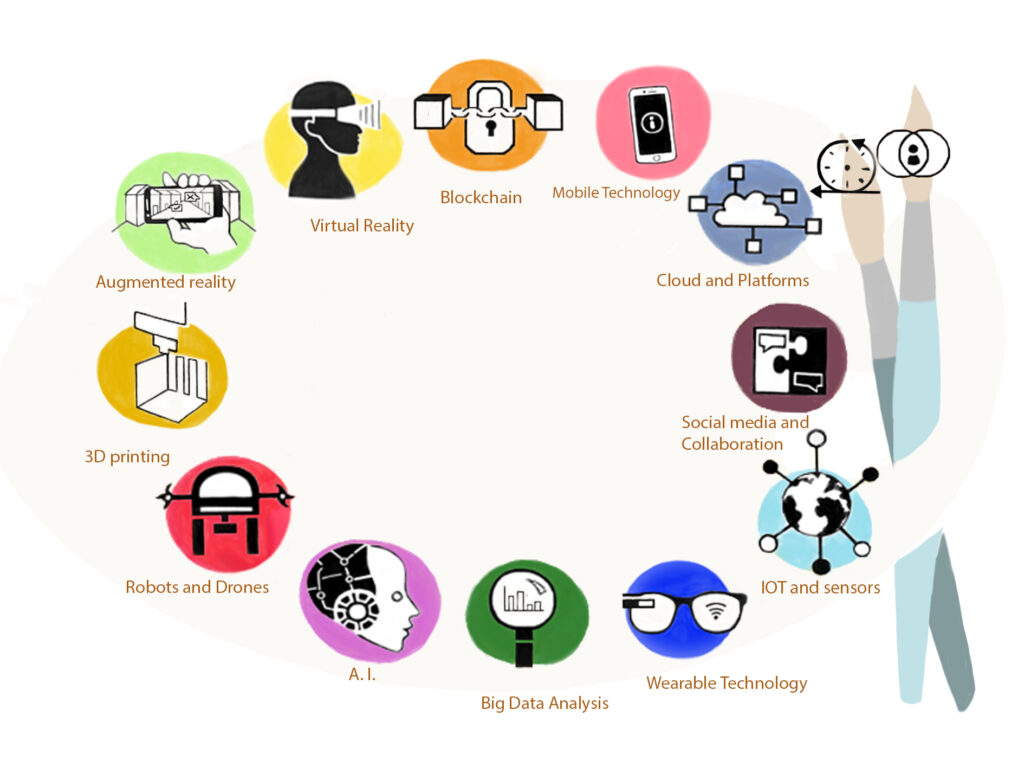We hear a lot about Digital Transformation and the impacts it brings to consumers and companies alike, with new business models and superior customer experience. Companies need to embrace Digital Transformation and become disruptors, less they run the risk of being disrupted by newcomers and potentially become irrelevant.
Kodak is a great example where the fast transition to digital cameras led the company to bankruptcy just 18 months after a record profit. Many other industries have seen similar disruptions – think about the betting industry, hotels (Airbnb), transportation (Uber) and so on.
But in order to drive Digital Transformation, the first question to address would be “what is actually Digital Transformation?” Many of us would come up with different answer, or find this term actually quite vague. Lack of clarity on what Digital Transformation is a challenge to anticipate risks of disruptions and create competitive edge for your own company. So how do you know if you are on the right path?
Let’s start with the definition: Digitisation is the conversion of information from analog into a digital form that can be processed by a computer. When this process is leveraged to improve business models, work processes and customer experience, it is called digitalisation. The results of this process are called digital transformation.
As an example, the CD was the first digitisation of music (converting music to ones and zeros), which led to iPod and music streaming. Technological advances like mobile phones and 4G spur the possibility of new services like Spotify.
What is digital transformation?
To help you understand the definition and scope of Digital Transformation, we at NovAzure came up with the concept of ‘Digital Palette’ (© NovAzure) which is made up of 12 digital technologies. Like a painter in front of his canvas, business leaders will need to reflect on which mix of digital technologies is relevant for their own businesses – to create the impact they are hoping for.
With a series of articles, we will dive into each aspect/technology of the Digital Palette – to uncover how these technologies have been evolving and what could still be untapped opportunities for relevant industries.
The Digital Palette© : 12 Digital Technologies
We identified 12 key technologies as the main drivers of Digital Transformation.
1. Mobile Technology
Mobile technology drives mobile devices such as cellular phones, laptops, tablets, and allows us to perform a wide variety of tasks. Through the adoption of mobile technologies, businesses have been able to achieve increased revenues, efficiency and innovations, as they can reach more customers, increase marketing/sales opportunities, and increase productivity by on-the-go mobile data capture, dashboards that share real-time information, and applications that facilitate smoother operations.
2. Cloud and Platforms
Cloud Computing, referred to as “the cloud”, is the delivery of computing services- servers, storage, databases, networking, software, analytics and more over the internet on a pay-for-use basis. It is like a large IT infrastructure network connecting thousands of systems to provide cost-effective data storage and data manipulation. One benefit of using cloud computing services is that firms can avoid the upfront cost and complexity of owning and maintaining their own IT infrastructure, and instead simply pay for what they use, when they use it.
3. Social Media and Collaboration
Social collaboration refers to processes that help multiple people or groups interact and share information to achieve common goals. Social media platforms enable people to make new connections and collaborate. Social networks are becoming unique touch points to engage communities, start conversations, recruit skilful employees, and develop new innovative ideas.
4. IOT and Sensors
The Internet of Things, or IoT, is the concept of connecting billions of physical devices around the world to the internet, collecting and sharing data. This includes basically everything from cellphones, coffee makers, washing machines, headphones, lamps, wearable devices, etc. Businesses are using smart interconnected devices (e.g. RFID, sensors, etc.) to get more visibility into the identification, location, and condition of products, assets, transactions, or people, and in turn to drive more effective, timely business decisions or to improve customer interactions.
5. Wearable Technology
Wearable technology refers to electronics technologies that are designed to be worn anywhere around the body therefore enabling hands-free operations. These devices can perform many of the same tasks as mobile phones and laptop computers – in some cases, actually outperform these hand-held devices entirely. From healthcare to military/defence sector, this technology is prevalent due to ease of use, flexibility, and convenience. It also saves time, enables real-time data monitoring, and offers operational efficiency.
6. Big Data Analysis (Analytics)
Big data analytics is the application of advanced analytic techniques to very large data sets. Gartner’s (2012) definition of Big Data being ‘high-volume, high-velocity and/or high-variety information assets that demand cost-effective, innovative forms of information processing that enable enhanced insight, decision making, and process automation’ summarises succinctly the main benefits of big data analytics. They are to draw insight from data, to make better decision based on the insight, to automate the decision and bake it into a business process – hence process automation.
7. Artificial Intelligence (AI)
Artificial Intelligence is a collective term for computer systems that can sense their environment, think, learn, and act in response to what they’re sensing and their objectives, traditionally done by people. AI makes it possible for machines to learn from experience, adjust to new inputs and perform human-like tasks. Although AI can be deployed to automate certain functions, the technology’s greater power is in complementing and augmenting human capabilities.
8. Robots and Drones
Robots are programmable machines which are usually able to carry out a complex series of actions autonomously, or semi-autonomously. Robots interact with the physical world via sensors and actuators. Drones, formally known as unmanned aerial vehicles (UAVs) or unmanned aircraft systems (UASes) are flying robots. Together, drones and autonomous robots can help shrink various costs in Oil & Gas industry’s upstream operations as an example.
9. 3D Printing
3D printing, also known as Additive Layer Manufacturing (ALM), creates three-dimensional solid objects from digital blueprint files. Objects are created by laying down successive layers of material, each of which is a thinly sliced horizontal cross section of the final object. 3D printing enables businesses to print objects, such as machine parts, at convenient locations, thereby reducing the production time and shipping costs involved. The new developments in 3D printing reduces complexity, enabling highly optimised, on-demand and customisable solutions at little additional cost per unit, while enabling innovation by experimenting with new materials.
10. Augmented Reality
Augmented Reality is a technology that lays computer-generated images over a user’s view of the real world. It is a fully immersive experience for the user without interaction of the physical world around them. AR at work could increase visibility with clients, provide more engaged training, improved leader/staff communications, and remote learning and development. For businesses, AR would lead to new business models/offerings, better marketing, increased efficiency and better collaboration.
11. Virtual Reality
Virtual Reality is a computer-generated simulation of 3D environment that a user can interact with in a seemingly real way through the aid of a headset and/or gloves; but it’s essentially quite an isolating experience. VR enables companies to promote their products with an amazing blend of photography and technology that leads to interactivity.
12. Blockchain
Blockchain is a way of storing and moving data, wherein instead of holding data in one place the information is spread over thousands of nodes across a network, all locked together with the help of cryptography. Recording transactions through blockchain virtually eliminates human error and protects the data from possible tampering. In addition to the guaranteed accuracy of the records, such a process will also leave a highly traceable audit trail.
Why Digital transformation is disruptive?
We have identified 6 key reasons why Digital transformation is disruptive for business:
- It is cheap and democratised, where new entrants can disrupt very quickly incumbent businesses with limited initial investments (coding a new application on iPhones IOS can be done for just a few thousand dollars)
- It has a quick time to market as the speed of development and distribution of current technology is significantly accelerated compared to previous technologies and the pace of innovation is accelerating (coding a new application and deploying it on iPhones IOS can be done in a few weeks/months)
- It is global as a digital solution can be applied globally without needing too much adaptation to local markets besides languages (e.g. Uber app)
- It changes fundamentally the customer expectations which have become much more sophisticated and constantly evolving, with digital presence means there are more channels (and relevant) to reach out to customers.
- It unlocks new business models that incumbents have difficulty to adapt to as fast as new entrants
- It is a cultural change which transforms the way we do business, with much more agile practice, collaboration, and constant innovation
How should Digital transformation be implemented
There are two key principles that are fundamental in any Digital transformation:
Customer centricity
Keeping the customer at the heart of any digital transformation is key. Using customer panels with whom you deliver the product, engage designers to ensure the customer experience is optimised to address the key pain points and expectations from customers. And by harvesting the right insight from data, you can proactively anticipate customers’ needs and expectations, thus fulfilling their needs timely. E.g. Lyft uses data to continually revise its routes to be quicker and safer, while also remembering customers’ preferences for an easier experience.
Agile delivery
Agile delivery means trying fast and failing fast, accelerating learning to get to a solution that truly sticks with customers and open new business frontiers. By delivering in an agile manner in short sprint cycles, new experience can be delivered in a matter of weeks, not months as typical traditional project management.
By Jean-Jacques Jouanna (Jan 2020)
Interested to know more or share your thoughts? Or keen to understand how NovAzure can help you transform digitally? Please contact us at info@novazure.com and we will be delighted to hear from you.





